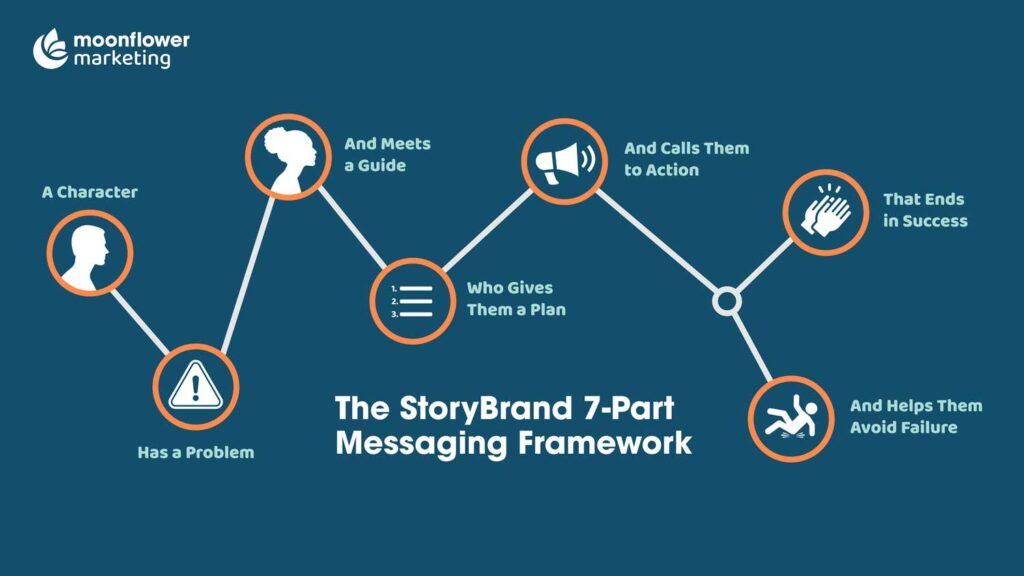Running a nonprofit organization is hard! You are passionate about doing great work in our world, which can take up every ounce of your being.
Yet, somehow, you have to find time to build a website, figure out what to say on that website, create engaging social media posts, solicit donations, build a coalition around your cause, and get new volunteers.
Yeesh! I’m exhausted just thinking about it.
I know just how hard it can be. In 2020, I co-founded a locally-based nonprofit, the North Shadeland Alliance, to advocate for residents and businesses in my community following increased crime and violence. I’m also on the board of Binford Redevelopment and Growth (BRAG), and Lawrence Community Champions, which work in our greater community.
I understand how difficult it can be to balance doing the work you feel called to do and building the organization to make an impact. Especially when working with volunteers or part-time staff.
Good news! Using the StoryBrand messaging framework for your nonprofit can simplify everything and make you more confident in growing your nonprofit.
Let’s take a look.

What is the StoryBrand Framework?
We have an entire page dedicated to StoryBrand, so we’ll just give you a quick overview.
The StoryBrand framework is a brand messaging framework that utilizes storytelling elements to help you invite your audience into a story of transformation. It positions the audience as the hero in the story and your organization as the guide who understands them gives them a plan, calls them to action, and leads them to success.
It is well-proven that using elements of storytelling to craft your nonprofit marketing message works.
Download our FREE StoryBrand Homepage Template

How does StoryBrand for Nonprofits work?
For a typical business, you would likely have one main StoryBrand BrandScript for the company. The difference in using it for nonprofit organizations is you have two main BrandScripts—one for your mission and the other for the people who make it happen, your donors.
These BrandScripts help you invite your participants and donors into a story of transformation. Instead of just presenting your work and the details, you invite people into a transformative story, which is far more persuasive.
You want to use these BrandScripts everywhere you use words to reach the subject of your mission and your donors. You especially want to create a StoryBrand website that implements this messaging on the homepage and a donor-specific page.
Here is how you would consider BrandScripts for each use.
Applying StoryBrand to Your Mission:
I consider this your “main” BrandScript.
You created your nonprofit to serve a mission and make a difference. So, your main BrandScript will position the people you serve as the “hero” of your story. You will outline their problem, give them a plan to overcome it, call them to action, and help them avoid failure and achieve success.
Ask the following questions concerning each part of the framework to position the subject of your mission as the hero.
Character:
What do the people your nonprofit organization is working to help specifically want or need from you?
Problem:
When positioning the problem for the people you want to help, you must consider three parts of a problem.
External Problem:
What is the apparent problem you are working to solve? Maybe it is safety, security, hunger, trafficking, environmental issues, etc. It is why you formed your nonprofit.
Internal Problem:
How do the people you are trying to serve feel about this problem? Are they frustrated, discouraged, scared, angry, etc.?
Philosophical Problem:
What would the people you serve say about their problem? Usually, this comes in the form of a “Should” or “Should not” statement. For example: “No child should go to bed hungry.” You typically would state this in the form of, “At X Nonprofit, we believe no child should go to bed hungry.”
The Guide
We look at how you step into the story as the Guide in two ways.
Empathy:
How can you express empathy toward the people you are serving? How do you feel their pain?
Authority:
What gives you the authority to help them overcome their problem? Have you done this before? What do the people you’ve already helped say about you (testimonials)? What related organizations have you worked with to solve this problem (borrow authority from known organizations)?
The Plan:
Now it’s time to show them how you intend to help them overcome their problem. They need to know you have a clear plan to get them there.
Create a three-step plan that either shows them how easy it is to work with you, or how simple it is to go from where they are, overcome their problem, and find success.
Call them to Action:
At this point, the people you hope to serve see that you understand their problem and how they feel about it. They see you have a plan to help them overcome it. Now, they need to know what one thing they need to do next to get started.
This is your call to action. Maybe it is “sign up,” “register,” “show up,” “apply,” etc. Whatever your one thing is, state it clearly.
Don’t use calls to action like “Learn More” or “Contact Us.” These are weak calls to action and tend not to drive actual action.
Find Success:
People need to know where you are taking them. Show them. Tell them. Through every way possible, paint a picture of what success looks like on the other side of participating in your mission.
Avoid Failure:
What does it look like if the people you hope to serve don’t find success? What are you helping them avoid? While you don’t want to harp on this, you do want to mention this possibility, at least.

Applying StoryBrand to Your Donors
Once you have clearly defined the story you are inviting the subjects of your mission into, you will need to create a separate BrandScript for your future donors. These are the people who are going to join you in the mission.
While the people you serve are the REAL heroes of your story, you will want to position your donors and volunteers as heroes in this version of the story as well.
You need to understand what motivates a person or an organization to contribute financial resources to a mission.
Here are some questions you might ask of donors concerning each part of the StoryBrand framework.
Character:
What do your donors want from your nonprofit? What change do they hope to effect in the world? How do they want to be perceived by donating to your organization?
Problem:
Again, we will look at the three parts of a problem in a story.
External:
What prevents donors from achieving the impact they want to see in the world or from being perceived the way they want to be perceived?
Internal:
How does it make them feel that the problem from your main BrandScript exists, and they aren’t able to help change it?
Philosophical:
What would your donors say about their problem?
Again, this often looks like a “Should” or “Should not” statement. It could be the same Philosophical problem as your main brandscript. “No child should go to sleep hungry.”
The Guide:
Position your organization as the guide in the donor narrative using empathy and authority, as before.
Empathy:
What statement can you make that lets your ideal donor know you understand them?
Authority:
How can you uniquely position yourself to help your donor make a difference? Testimonials from current or former donors and partner organizations can build your credibility.
The Plan:
What steps can your ideal donor take to move from interest to becoming a donor? This might be something like “Set up a Call” to speak with someone from your organization. Then, “Make a contribution” to your nonprofit. Finally, “See your impact!”
We like to make the last step a success point. Telling donors that they will “See Your Impact” lets them assume they will see the impact and you will continue to show them what their impact looks like over time. It keeps them in the loop and connected (and maybe more likely to donate multiple times or continually).
Call to Action:
What is the ONE THING they need to do to start the process of becoming a donor? Now, I’ll be honest, while we typically say ONE THING, in this case, I would say TWO THINGS.
- Set up a Call (to speak to a rep and learn more)
- Donate Now (online donation form for lower-lever donors)
Your high-dollar donors will likely want to speak to someone personally before dropping $35k on your nonprofit organization. However, you need to give folks who want to donate $25 a no-friction option to make that contribution online.
Find Success:
What does success look like after your donors contribute to your nonprofit? You can double-dip on this one. Show what success looks like for both your donor and the subjects of your work. Your donor might find pride in making a difference, but show them what that difference looks like too.
Avoid Failure:
You can double-dip on this one too. You need to show your donors both what you are helping them avoid, and what you are helping the subjects of your work avoid. They need to see the dual consequences of not contributing to your nonprofit.
Again, don’t harp on this, but don’t fail to note the bad things you are helping donors and recipients avoid.
Invite People into a Story, and Your Nonprofit Will Have Greater Impact
People respond when they feel invited into a story. That is true for the recipients of your work as much as the donors who fund your essential work.
If both audiences feel like they’re stepping into an exciting story of their own transformation (as well as others’), they will be more likely to participate.
What questions do you have? Leave a comment below or hit us on Twitter, Facebook, Instagram, or LinkedIn.





0 Comments